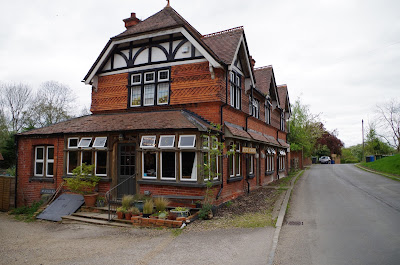Locked and Boulted
The Defence Section
Continue until you come to a cross roads that has Kiln Hill to its right, turn there towards White Waltham, and then turn right again.In the village go left by the war memorial, which is next to the cricket pitch, along Butchers Lane.Around 500m a gap on your right leads to gates and a wire fence. This is the boundary of White Waltham Aerodrome, with a perimeter road just past the fence. The immediate section has been given over to crops, but beyond is one of the busiest light aircraft airports in the UK. You can see hangers and planes in the distance. During WWII White Waltham was the HQ of the Air Transport Auxiliary which was responsible for ferrying planes from
 |
| White Waltham Aerodrome |
Not completely flat, Butchers Lane takes you up to the A4. While it's not very busy here take care as you turn left and then soon right for Warren Row. You keep on the road, turning sharp left ,while Pudding Hill keeps straight. About 100m on from that junction is The Warren Row Bunker. It was first developed in WWII as a secret underground factory for the production of aircraft components. It consists of tunnels fifteen to twenty feet wide and about 600 yards in length. From 1958, during the Cold War, it became a Secret, Regional Seat of Government. "Discovered" by Spies for Peace, an anti-nuclear group in 1963, it continued in use until 1988. It is now used by a wine company.
 |
| The bunker main entrance |
 |
| St Paul's Mission Church |
At the end of Warren Row, on your right, is Velolife which is a coffee shop for cyclists and a bike repair place. Unlike pubs which don't open until 12:00 you can get drinks and snacks here staying within event time limits, though it is not an Audax control. It can be recommended for its excellent coffee.
 |
| Velolife |
The gentle climb continues for a while then you reach an almost flat section which leads you to the T junction with the A4130. Turn left and soon right to Aston. You get a long descent from here - there are a few potholes, mainly about halfway down, and gravel in the middle of the road. Turn left next to the Flower Pot pub and after a few meters climb, there's a metalled track on the right with a gate. Wiggle you bike through the kissing gate and cycle to the lock.
The pound lock was first built in 1773, with Hambleden weir dating back to medieval times, though the current one is recent, rebuilt in 1996. Hambleden is a major venue for canoeing. The weir has underwater flaps that can be adjusted by air filled cushions to improve wave conditions. If you are lucky you will see a grey wagtail and if you are very lucky, a Kingfisher. You need to walk across the lock gate and then along the weir towards the mill, which is now flats.
|
A grey wagtail
The mill
 |
| The lock and weir |
More about the ride Enter now



No comments:
Post a Comment